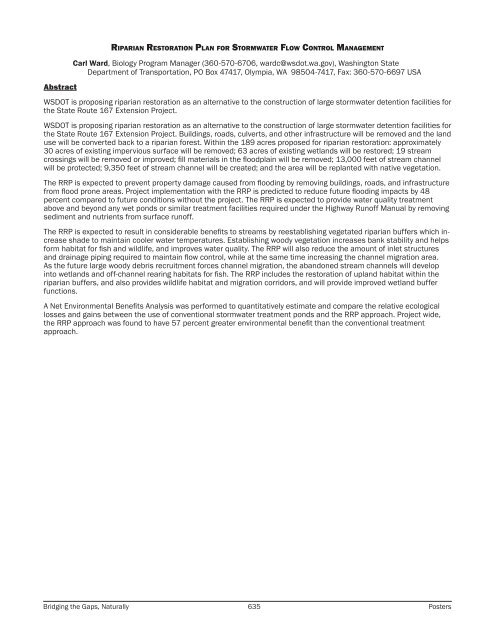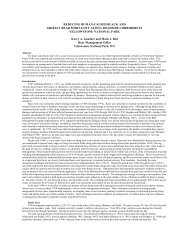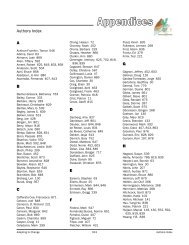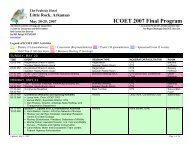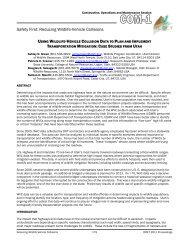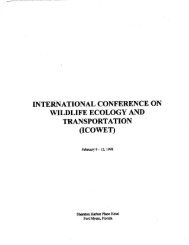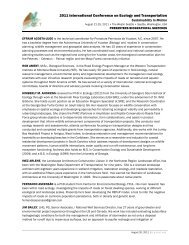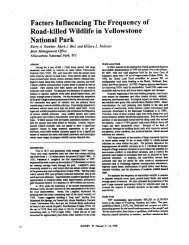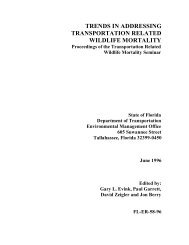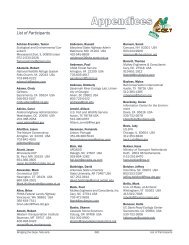Poster Sessions, pages 567-640 - ICOET
Poster Sessions, pages 567-640 - ICOET
Poster Sessions, pages 567-640 - ICOET
You also want an ePaper? Increase the reach of your titles
YUMPU automatically turns print PDFs into web optimized ePapers that Google loves.
Abstract<br />
Riparian Restoration Plan for Stormwater Flow Control Management<br />
Carl Ward, Biology Program Manager (360-570-6706, wardc@wsdot.wa.gov), Washington State<br />
Department of Transportation, PO Box 47417, Olympia, WA 98504-7417, Fax: 360-570-6697 USA<br />
WSDOT is proposing riparian restoration as an alternative to the construction of large stormwater detention facilities for<br />
the State Route 167 Extension Project.<br />
WSDOT is proposing riparian restoration as an alternative to the construction of large stormwater detention facilities for<br />
the State Route 167 Extension Project. Buildings, roads, culverts, and other infrastructure will be removed and the land<br />
use will be converted back to a riparian forest. Within the 189 acres proposed for riparian restoration: approximately<br />
30 acres of existing impervious surface will be removed; 63 acres of existing wetlands will be restored; 19 stream<br />
crossings will be removed or improved; fill materials in the floodplain will be removed; 13,000 feet of stream channel<br />
will be protected; 9,350 feet of stream channel will be created; and the area will be replanted with native vegetation.<br />
The RRP is expected to prevent property damage caused from flooding by removing buildings, roads, and infrastructure<br />
from flood prone areas. Project implementation with the RRP is predicted to reduce future flooding impacts by 48<br />
percent compared to future conditions without the project. The RRP is expected to provide water quality treatment<br />
above and beyond any wet ponds or similar treatment facilities required under the Highway Runoff Manual by removing<br />
sediment and nutrients from surface runoff.<br />
The RRP is expected to result in considerable benefits to streams by reestablishing vegetated riparian buffers which increase<br />
shade to maintain cooler water temperatures. Establishing woody vegetation increases bank stability and helps<br />
form habitat for fish and wildlife, and improves water quality. The RRP will also reduce the amount of inlet structures<br />
and drainage piping required to maintain flow control, while at the same time increasing the channel migration area.<br />
As the future large woody debris recruitment forces channel migration, the abandoned stream channels will develop<br />
into wetlands and off-channel rearing habitats for fish. The RRP includes the restoration of upland habitat within the<br />
riparian buffers, and also provides wildlife habitat and migration corridors, and will provide improved wetland buffer<br />
functions.<br />
A Net Environmental Benefits Analysis was performed to quantitatively estimate and compare the relative ecological<br />
losses and gains between the use of conventional stormwater treatment ponds and the RRP approach. Project wide,<br />
the RRP approach was found to have 57 percent greater environmental benefit than the conventional treatment<br />
approach.<br />
Bridging the Gaps, Naturally 635 <strong>Poster</strong>s


